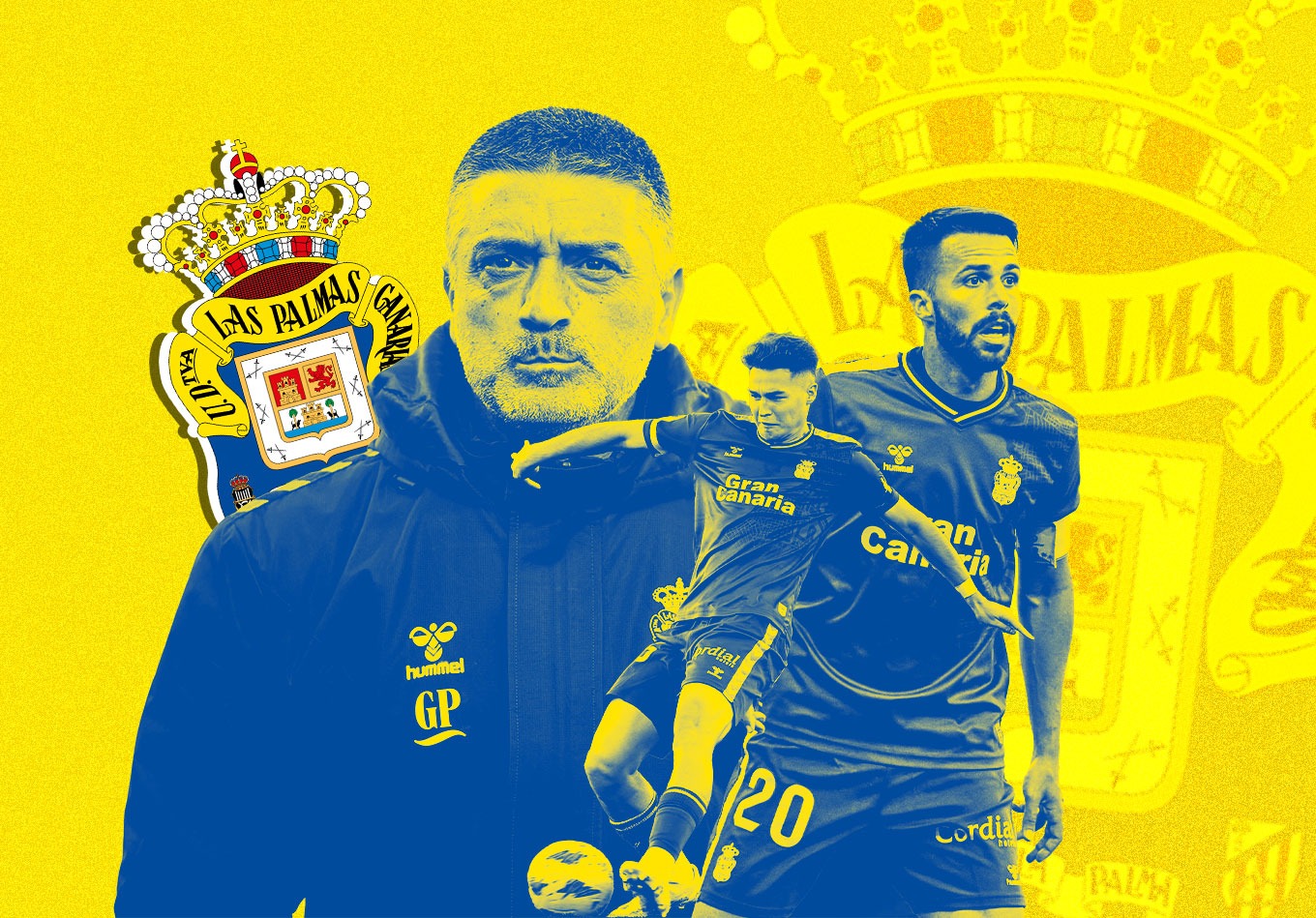Las Palmas were only promoted to La Liga last season, but after 25 games in 2023-24, European qualification looks more realistic than relegation. We analyse how they’ve done it.
“They’re so good. What are we going to do?” Kirian Rodríguez laughed to himself as he considered his own question last weekend.
“Play, and keeping doing the same,” he swiftly concluded. “I think this is the moment to reinforce it.”
Las Palmas had just lost 5-0 at Atlético Madrid, a game their manager described as “stupid” and in which they’d committed just about every error possible over the course of 90 minutes. The last man getting tackled while dawdling on the ball, a penalty conceded, botched clearances, losing the ball in your own half with the goalkeeper 35 yards out of his net… you name it, Las Palmas did it. Saturday’s trip to the capital had been a hopeful one, but the optimism lasted about 15 minutes.
As is almost always the case, a heavy defeat that comes on the back of a team playing in an expansive way and not adapting to protect themselves provokes an unforgiving review. Had Las Palmas gone to the Metropolitano in a 5-3-2, defended their goal with 11 men and lost 5-0 anyway, the conclusion would’ve been much less about the approach and a lot more about the difference in quality between a promoted team and a Champions League one. Not to mention, this is an Atlético side that have taken 64 of their last 66 available home points in La Liga.
The reality is, when you pick a way to play, you also pick a way to lose. For Las Palmas, the same idea that saw them put to the sword on Saturday is the one that allowed them go to Madrid in a state of tranquillity in the first place, with European football a more immediate prospect than relegation.
Despite what one might think having seen Saturday’s game, García Pimienta’s side are punching well above their weight this season largely on the strength of their defensive record. Going into the weekend, they had conceded just 20 goals in 24 La Liga games on the season – the fewest at that point by a promoted side since Real Betis in 1994-95.
Indeed, this is the rather strange paradox of their campaign. While staying faithful to the Canarian traditions of associative football – with a team littered with ball-playing talent – Las Palmas’ games don’t usually produce much in terms of goals or goalmouth action.
Though they share the same technical flair and precision of pass as Quique Setién’s memorable 2015-16 side, this version uses the ball with significantly different intentions.
There’s a strange scene that happens from time to time in Las Palmas games, and it’s one that would send some coaches into a frenzied fit upon seeing their team do the same.
Los Amarillos win the ball back, and with their opponent not yet having had time to fall into a defensive shape, the opportunities to attack into the resulting space are clear and obvious to see. Perhaps the opposition left-back is caught high up the pitch, or the defensive midfielder is too far away to be able to protect his central defenders. For many managers, there will never be a better moment to attack than this: the moment just after winning the ball, with the opponent still in their attacking shape.
While your instinct as a spectator is to spot the space and expect the pass, Las Palmas don’t often comply. Instead, you’re just as likely to see the player in question lift his head, survey the scene, apply the brakes to a standstill, and wait for his teammates to arrive in the vicinity.
In García Pimienta’s side, travelling in comfort is preferred to travelling express.
“Everything that involves having the ball is to limit the rival attacking you. A lot of the time we have the ball and it seems like nothing is happening, that it’s inert possession. But in reality, we’re defending ourselves and catching our breath.”
Las Palmas defender Saúl Coco, November 2023 (Televisión Canaria)
Of course, Las Palmas don’t always guide their opponents back into defensive shape, as if politely holding a door open for someone approaching. It’s in those moments, however, that we’re best able to see the sheer level of conviction in their style. Against the combination of a player’s natural instinct to go forward and the noise levels spiking in the stadium (“go on!”), those on the pitch have been coached to constantly weigh up what the collective effect of their decision will be.
Turning down a counterattack might bring you some momentary groans, but the islanders aren’t in the business of quick wins.
Las Palmas are averaging 294 passes per game in their own half this season – the most by a team in a La Liga campaign since Barcelona of the early 2010s. Indeed, the Catalans averaged precisely the same number per game in both 2010-11, under Pep Guardiola, and 2012-13, under Tito Vilanova.
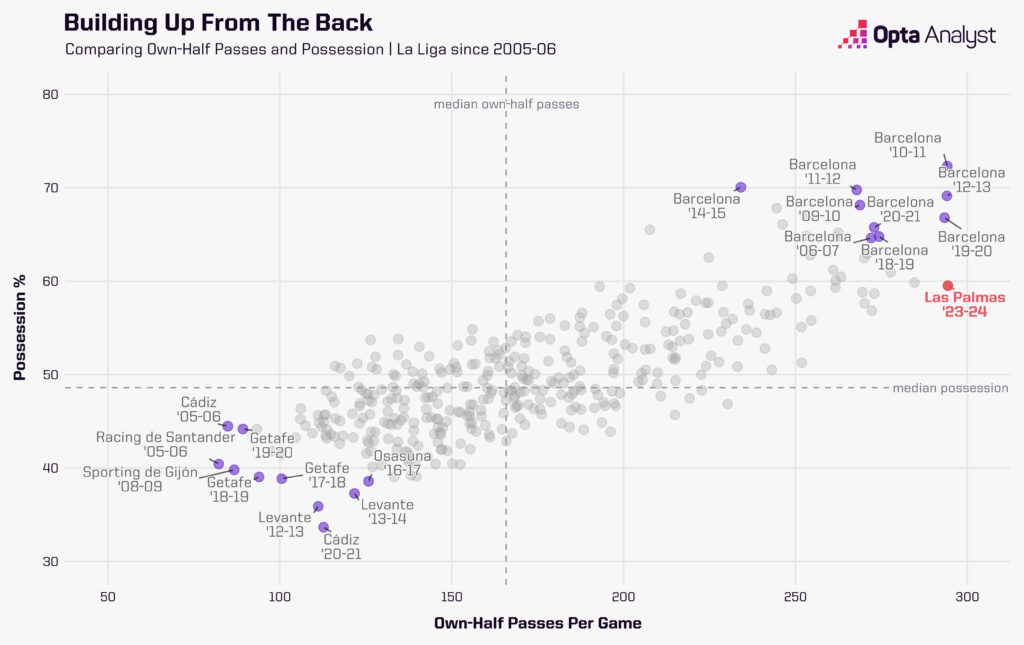
Like any good coach, the central idea for García Pimienta revolves around the tools he has to work with. Las Palmas are replete with technical players; the type that like passes to feet and know the ball moves quicker than they ever will. In a team that lacks difference-making final-third talent and formidable individual defenders, the mere act of having the ball – and keeping it – is what has provided their sense of place in La Liga.
Their standard 4-3-3 takes on many forms in that process, depending on the opponent. The shape easily shifts between a 3-4-3, a 4-2-3-1 or a 4-4-2 with a box midfield, and the patience with which they build allows them to constantly be modifying and resetting that alignment in response to their opponent. So much so, Mika Mármol’s 332 passes to goalkeeper Álvaro Valles are the most from one player to a specific teammate in La Liga this season.
Playing back to square one in this team doesn’t mean a failed expedition, but rather the chance to change the landscape without giving up possession.
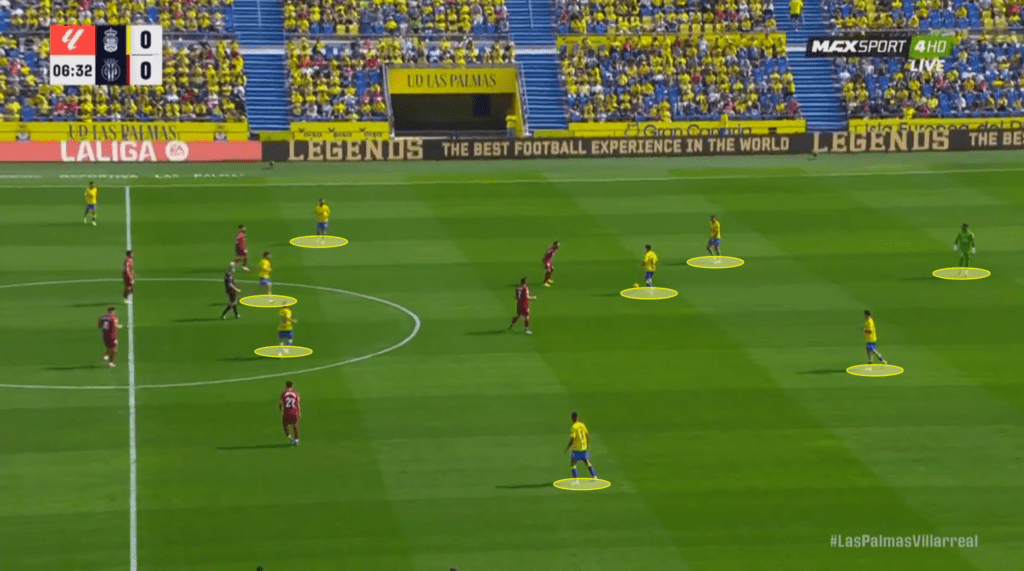
Whatever the displacement of players on the pitch is, Las Palmas prey on having the numbers advantage around the ball. It’s through those short connections that they can build passages of play but do so while keeping the game under their spell. When they do ultimately have to go back to the goalkeeper, Las Palmas prevent the opposition squeezing up by using Valles well off his line. Unlike with a longer pass back into the penalty area, the short pass to Valles doesn’t allow it – and so the ball stays in motion, with Las Palmas retaining the field position.
There’s an overwhelmingly collective feel to their play, but as in every team, there is one presence that stands tallest. For Las Palmas, that figure is the aforementioned Kirian Rodríguez. Whether he plays as the pivote or as an interior, the 27-year-old is a quarterback in presence but more of a regulator in practice. He’s the one who manages the flow of traffic and marks the tempo of how the team use the ball, as well as the one who reprimands any pass that threatens to take the team off-script. In their game of Canarian-style association, the native of Tenerife sets the example.
Across La Liga, Girona’s Aleix García (1,737) is the only player who has completed more passes than Kirian (1,732) this season. Beyond being the defined leaders of their team along possession lines, that’s about where the comparison ends. While García dominates through his longer, more penetrative distribution, the Las Palmas midfielder is the one who provides safe passage from back to front, steering the ball through a series of combinations, and stacking short but repeatable passes.
Though defender Mármol figures as an honourable mention, there is no one who defines the team’s intention quite like Kirian. Just like the player himself, Las Palmas need the ball to be able to survive in their new environment.
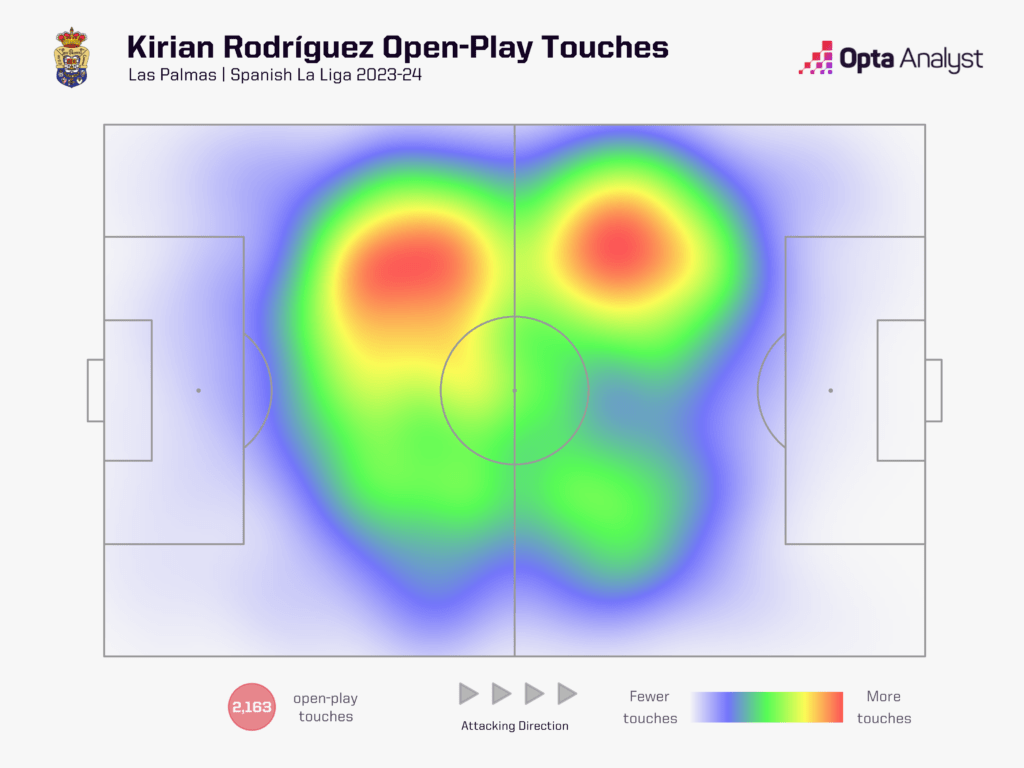
The biggest effect of Las Palmas’ approach this season is that they’ve barely ever been ‘out’ of the game. Across their 25 fixtures in La Liga this season, they’ve been behind on the scoreboard for just 14% of their total match minutes – a figured tied with league-leaders Real Madrid.
Through their ultra-patient management of the ball and the fact they almost never grant ‘open action’ — whereby the play flows between both boxes, having gotten away from them — Los Amarillos essentially keep the game on a string. No team in Europe’s big five leagues have seen fewer first-half goals in their matches this season (0.56 per half), yet their goal difference (+4) in those is bettered only by current top-six sides in La Liga, through an aggregate score of 9-5.
What a way to make a living, one might say.
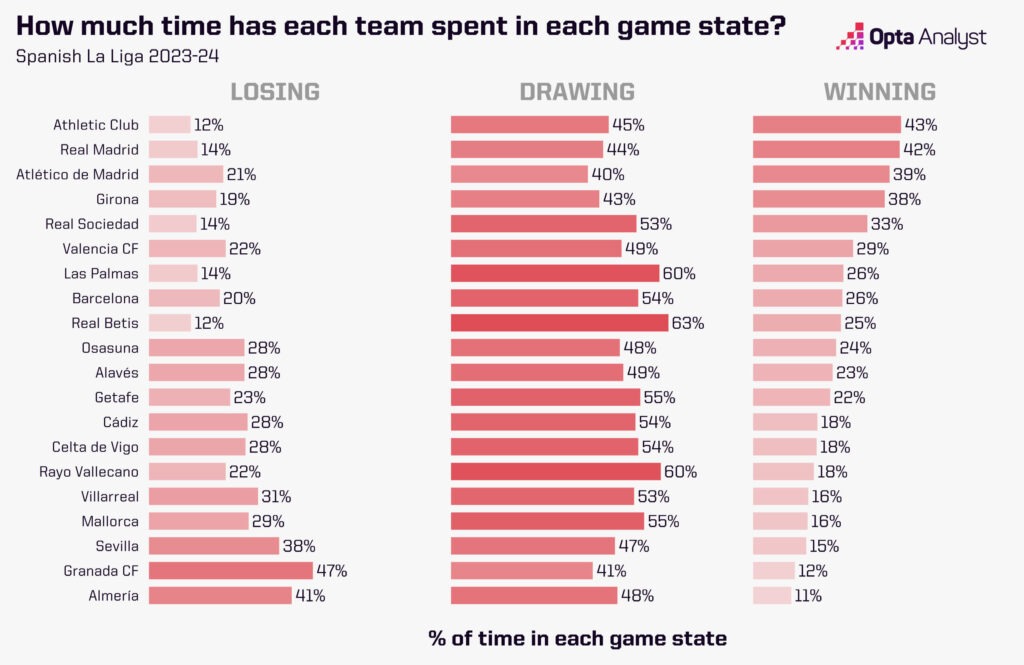
Even when they attack, Las Palmas do it by travelling together. It’s a method which is based heavily around what will happen the moment the attack ends, rather than maximising the possibilities of creation at the expense of risk. Of course, most coaches factor the defensive side in their offensive ideas to some degree, though few take it quite to the level of García Pimienta’s side.
While they have more of the ball than every other team in La Liga except Barcelona, Las Palmas are the team who cross the ball least often from open play and make the fewest switches of play in the division. It demonstrates a very conscious pursuit of keeping the game stitched together, whereby they manage the landscape and limit landing themselves in vulnerable spots. Suffice to say, the fact they’ve only allowed their opposition 11 fast breaks in 25 games this season is much more a desired outcome than it is a by-product of their play.
It was a certain Pep Guardiola who once said making the transition between defence and attack was “impossible” without a sequence of 15 passes. And for García Pimienta – a coach who was formed within Barcelona at La Masia – the idea is much the same. Of the four longest passing sequences leading to goals in La Liga this season, half of them have been scored by Las Palmas.
In the 26-pass move against Villarreal below, note how – even following a rare switch of play – they still re-organise on the opposite side of the pitch before proceeding with the attack.
It’s not as if Las Palmas go into games with the intention of killing minutes at 0-0, but their considered style of possession football seeks to keep them within reach of the result while they pick their way around the opposition. By spending so much time in control of both the tempo and direction of games, the islanders have been able to use that neutral game state to their advantage, making their goals count instead of trying to count the goals.
In the roughly 1,500 minutes they’ve spent drawing in La Liga this season, Las Palmas have only conceded an average of 0.7 goals per 90 minutes. Compared across the division, only Real Madrid (0.52) and Real Betis (0.66) have let in fewer goals per 90 having been level on the scoreboard at the time of conceding.
Having gotten so comfortable managing the margins, García Pimienta’s side rarely have to alter their way of playing. That’s to say, forcing the issue and throwing the kitchen sink doesn’t often come into their equation. Though being ahead typically grants some extra space to play with when the opponents take a step up the field, it doesn’t differ too much from their approach when level: methodical, but antagonistic at the same time. If their opponents start chasing and lacking discipline, Las Palmas can change the tempo after having lulled them into a state of drowsiness.
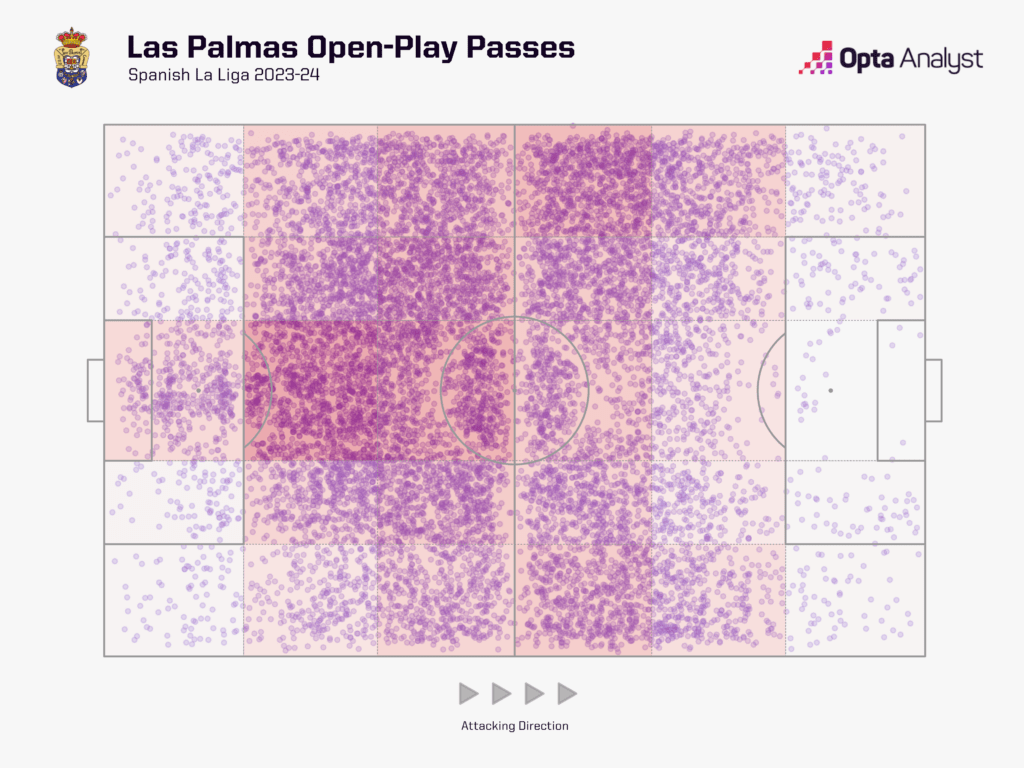
“Soccer,” Marcelo Bielsa once said, “rests on four fundamentals, as outlined by Óscar Tabárez: defence; attack; how you move from defence to attack; [and] how you move from attack to defence. The issue is trying to make those passages as smooth as possible.”
Perhaps the only time Las Palmas do attack with tunnel vision for goal is when they’re able to recover the ball high; a process that is often linked to what they do with the ball. With their propensity to play a short and combinative game – avoiding frequent switches or forced crosses that risk overstretching the team – they remain well placed to be able to apply pressure with numbers when possession changes hands.
Only Real Sociedad (3.8) have allowed opposition fewer sequences of 10+ passes per game than Las Palmas (4.6) in La Liga this season. Meanwhile, only Athletic Club (8) and Atlético Madrid (6) have scored more often immediately following a high turnover than Las Palmas (4).
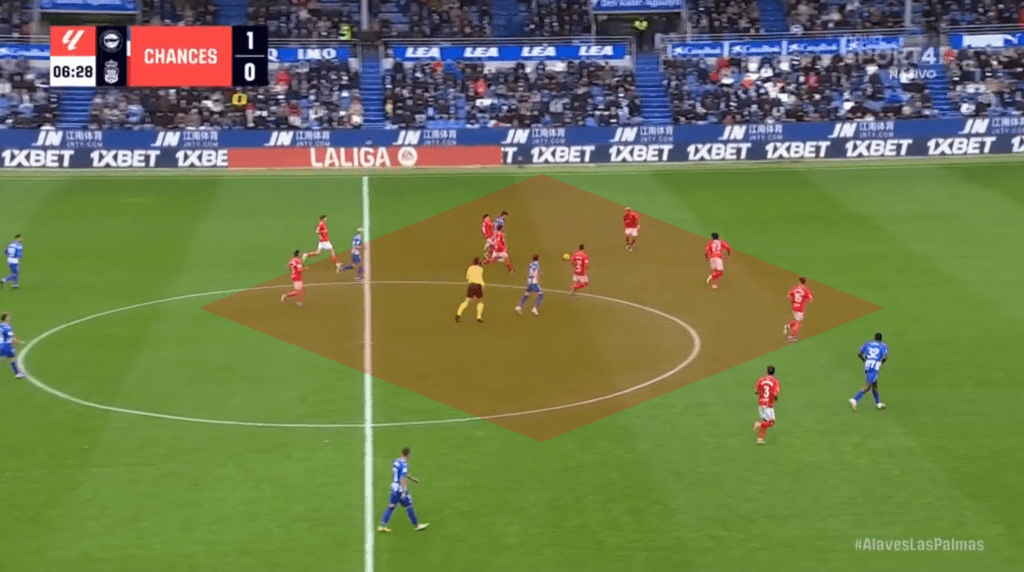
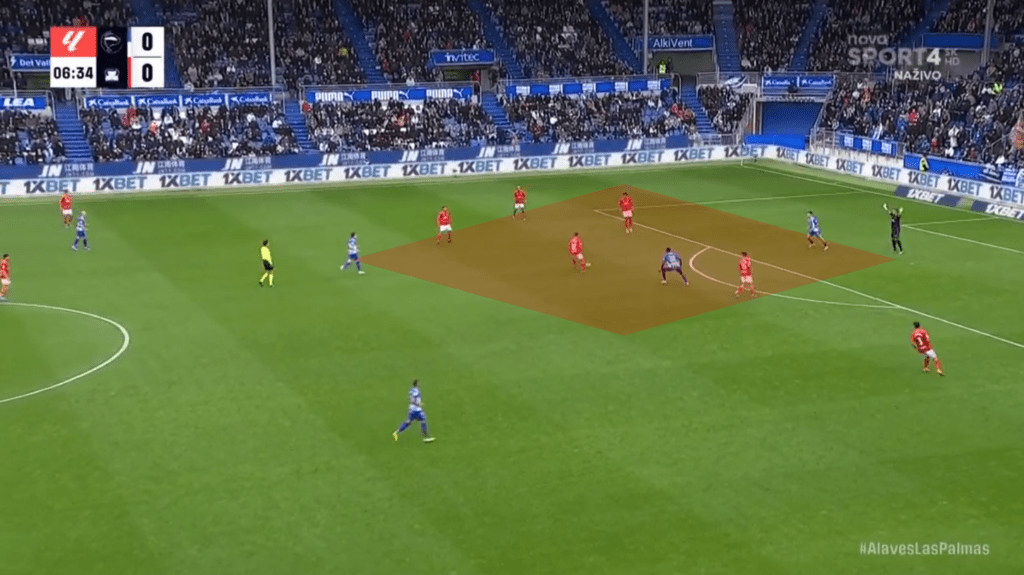
In many ways, Las Palmas’ approach to defending is about not doing much orthodox defending at all. By combining long spells of patient passing moves and applying swift pressure when they do lose the ball, they’re not called upon too often to drop back into a defensive shape in their own half. Or at least, they avoid it for as long as they possibly can.
Another method by which they put a barrier between themselves and that reality is through their high defensive line. Admittedly, using a high line these days is hardly revolutionary or rare to see, but Las Palmas do exaggerate theirs beyond its typical application. In their narrow 2-1 defeat to Barcelona in January – a game decided by a 93rd-minute penalty – Xavi’s side were caught offside on 14 separate occasions.
As part of their attempts to control field position, Los Amarillos lean on the offside flag more than any other team in La Liga. García Pimienta’s side have provoked an average of 4.8 offsides per game in the competition this season, the highest average in a single campaign since Villarreal in 2010-11 (5.6). It is, granted, an idea that relies heavily on co-ordination, timing, and the interventions of an alert goalkeeper, but the presence of Valles has certainly given confidence to the process.
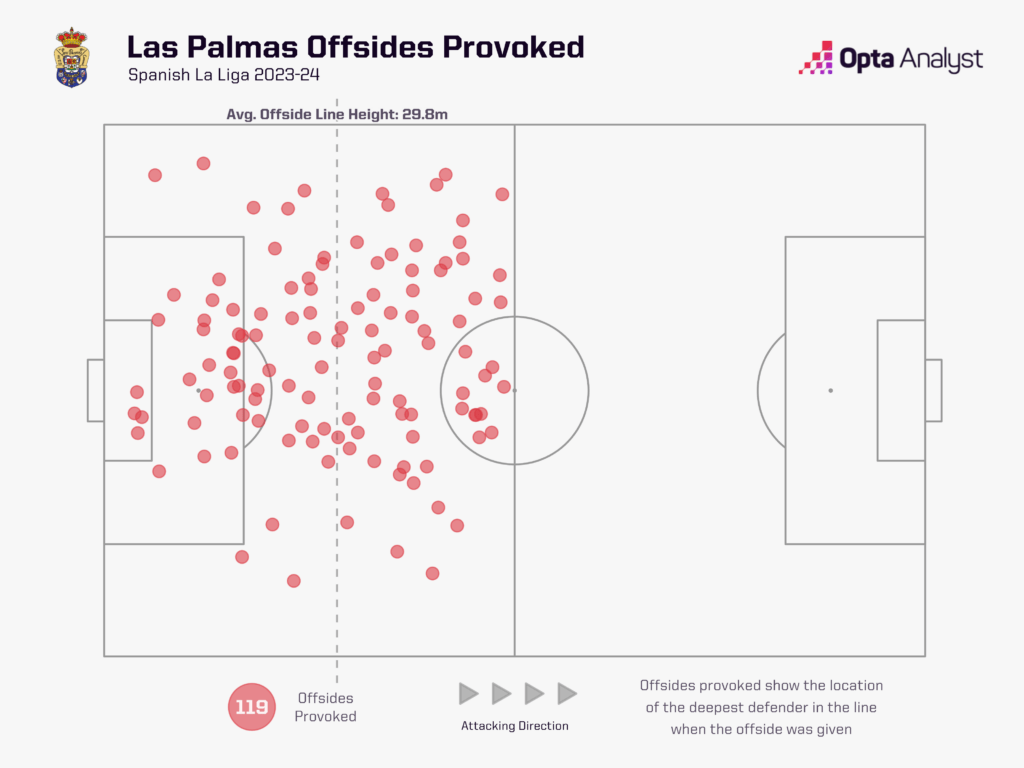
For many, Las Palmas currently occupy the spot of honourable runners-up to Girona as La Liga’s ‘revelation’ team of 2023-24. The Catalans, of course, are in just their second season back in the top flight and were in a similar position to Las Palmas last term as the rookies who gradually found their place while practicing a possession-based style of football.
Girona finished 10th in La Liga last term, while Las Palmas currently sit in ninth spot with a slightly higher points-per-game average (1.4) than the Catalans ended last season with (1.3). The big distinction to be made across the two sides – despite the common theme of being protagonists – is that Míchel’s side straddled the margins by trading goals. They would willingly receive a punch to be able to trade one, while Las Palmas try not to get hit at all. With just three goals separating the goal difference of Girona last term (+3) and Las Palmas at present (0), the former saw 113 goals scored in their matches last season; García Pimienta’s side are on track for just 76 goals come the end of this one.
Should the islanders manage to stay up, producing a second season like Girona’s would of course be an unrealistic aim. What Las Palmas are doing this season, however, is ultimately based around a longer-term outlook for the club. In their first campaign back, García Pimienta has used preservation of possession to protect the deficiencies and magnify the strengths of their squad. And in the absence of having clear attacking references or difference makers, their control of the ball has served to manage the margins.
Las Palmas’ possession has served primarily to protect them in their first year back, but a second season and opportunity to reinforce their weapons might well allow them to push the dial in the other direction in 2024-25.
Enjoy this? Subscribe to our football newsletter to receive exclusive weekly content. You should also follow our social accounts over on X, Instagram, TikTok and Facebook.
